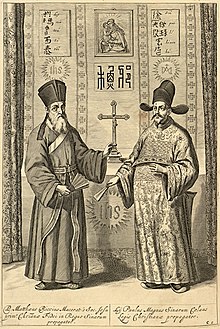Ritual dispute
The rites dispute , also known as the accommodation dispute , was a dispute lasting from around 1610 to 1744 about the manner of Christian missions , especially in China and India .
China
Since the beginning of the 17th century, a lively missionary activity developed in China , mainly carried out by the great Catholic orders, but also by the Russian Orthodox Church . Christian missionaries enjoyed great freedom , especially under Emperor Kangxi (1661–1722).
Until Matteo Ricci's death in 1610, the Jesuit mission was predominantly in favor of so-called accommodation . After that, the Chinese who had converted to Christianity were allowed to retain the traditional rites and ceremonies, in particular the worship of Confucius and ancestors . This procedure was quite successful, so that around 1720 there were around 300,000 Christians in China.
Ricci's successor, Niccolò Longobardo , considered the previously tolerated rites to be forbidden. Despite many consultations within the Society of Jesus, this question has not yet been decided. The conflict was exacerbated by the arrival of the Spanish Dominicans and Franciscans , who were in favor of an uncompromising mission without compromising Chinese customs. When Juan Bautista de Morales OP put this question to Rome, a decision was made there in 1645 against the Chinese rites. The Jesuits under Martino Martini declared these rites to be civil customs and were able to obtain permission from Pope Alexander VII again in 1656 .
Charles Maigrot wrote the pastoral letter Mandatum seu Edictum in 1693 , in which he opposed the Chinese rites, and reached Pope Clement XI. in 1704 a ban on Chinese customs. After a recursion by the Jesuits, this ban was confirmed in 1715. As a result, Emperor Yongzheng banned Christianity in 1724. After further examinations, Pope Benedict XIV banned the Chinese rites with his papal bull Ex quo singulari in 1742.
As a result, Christianity came under additional pressure: Missionary activities were forbidden, converts were persecuted and suppressed, and church life was largely pushed underground. Numerous missionaries had to leave the country; only the Jesuits who worked at the imperial court were allowed to stay. The mission had thus failed altogether. However, the communities scattered across China survived into the 19th century. The ban was in 1939 "as a result of the changed situation" by Pope Pius XII. canceled again. The abundance of contemporary publications in which European missionaries give their assessments and thus represent important sources of the image of China in Europe at the time can be seen as an important side effect of the rite dispute. In total there should have been over a hundred printed works on the rite dispute.
India
In India, Roberto de Nobili SJ came into conflict with his Portuguese confreres with his adaptation to Hindu rites and customs. Pope Gregory XV However, allowed on January 31, 1623 in the Bull Romanae sedis antistan Nobilis missionary method . The arrival of the Capuchins in India worsened the conflict. The papal legate Maillard de Tournon finally forbade the willful adaptation to Indian religious customs, Pope Clement XII. confirmed the ban in 1734 and 1739. A final condemnation of this type of mission was made by Pope Benedict XIV with the bull Omnium solicitudinum in 1744.
The ban was lifted here in 1940 by Rome.
literature
- Anton Huonder: The Chinese rite dispute. Xaverius, Aachen 1921.
- George Minamiki: The Chinese rites controversy from its beginning to modern times. Loyola University Press, Chicago IL 1985, ISBN 0-8294-0457-0 .
- Claudia von Collani (ed.): A scientific academy for China. Letters from the China missionary Joachim Bouvet SJ to Gottfried Wilhelm Leibniz and Jean-Paul Bignon about research into Chinese culture, language and history. Steiner-Verlag Wiesbaden, Stuttgart 1989, ISBN 3-515-05186-4 ( Studia Leibnitiana. Special issues 18).
- David E. Mungello (Ed.): The Chinese rites controversy. Its history and meaning. Steyler, Nettetal 1994, ISBN 3-8050-0348-X .
